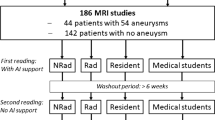Abstract
Background
Iodinated and gadolinium contrast agents pose some risk for certain pediatric patients, including allergic-like reactions, contrast-induced nephropathy (CIN) and nephrogenic systemic fibrosis (NSF). Digital flat-panel detectors enhance image quality during angiography and might allow use of more dilute contrast material to decrease risk of complications that might be dose-dependent, such as CIN and NSF.
Objective
To assess the maximum dilution factors for iodine- and gadolinium-based contrast agents suitable for vascular imaging with fluoroscopy and digital subtraction angiography (DSA) on digital flat-panel detectors in an animal model.
Materials and methods
We performed selective catheterization of the abdominal aorta, renal artery and common carotid artery on a rabbit. In each vessel we performed fluoroscopy and DSA during contrast material injection using iodinated and gadolinium contrast material at 100%, 80%, 50%, 33% and 20% dilutions. An image quality score (0 to 3) was assigned by each of eight evaluators. Intracorrelation coefficient, paired t-test, one-way repeated analysis of variance, Spearman correlation and receiver operating characteristic curve analysis were applied to the data.
Results
Overall the image quality scores correlated linearly with dilution levels. For iodinated contrast material, the optimum cut-off level for DSA when a score of at least 2 is acceptable is above 33%; it is above 50% when a score of 3 is necessary. For gadolinium contrast material, the optimum cut-off for DSA images is above 50% when a score of at least 2 is acceptable and above 80% when a score of 3 is necessary.
Conclusion
Knowledge of the relationship between image quality and contrast material dilution might allow a decrease in overall contrast load while maintaining appropriate image quality when using digital flat-panel detectors.







Similar content being viewed by others
References
Committee on Drugs and Contrast Media (2012) ACR manual on contrast media version 8. http://www.acr.org/~/media/ACR/Documents/PDF/QualitySafety/Resources/Contrast%20Manual/FullManual.pdf. Accessed 24 April 2013
Solomon R, Dauerman HL (2010) Contrast-induced acute kidney injury. Circulation 122:2451–2455
Weisbord SD, Palevsky PM (2011) Contrast-induced acute kidney injury: short- and long-term implications. Semin Nephrol 31:300–309
Halvorsen RA (2008) Which study when? Iodinated contrast-enhanced CT versus gadolinium-enhanced MR imaging. Radiology 249:9–15
Bruce RJ, Djamali A, Shinki K et al (2009) Background fluctuation of kidney function versus contrast-induced nephrotoxicity. AJR Am J Roentgenol 192:711–718
Newhouse JH, Kho D, Rao QA et al (2008) Frequency of serum creatinine changes in the absence of iodinated contrast material: implications for studies of contrast nephrotoxicity. AJR Am J Roentgenol 191:376–382
McDonald JS, McDonald RJ, Comin J et al (2013) Frequency of acute kidney injury following intravenous contrast medium administration: a systematic review and meta-analysis. Radiology 267:119–128
Katzberg RW, Newhouse JH (2010) Intravenous contrast medium-induced nephrotoxicity: is the medical risk really as great as we have come to believe? Radiology 256:21–28
Davenport MS, Khalatbari S, Dillman JR et al (2013) Contrast material-induced nephrotoxicity and intravenous low-osmolality iodinated contrast material. Radiology 267:94–105
Ajami G, Derakhshan A, Amoozgar H et al (2010) Risk of nephropathy after consumption of nonionic contrast media by children undergoing cardiac angiography: a prospective study. Pediatr Cardiol 31:668–673
Ellis JH, Cohan RH (2009) Reducing the risk of contrast-induced nephropathy: a perspective on the controversies. AJR Am J Roentgenol 192:1544–1549
Seeliger E, Sendeski M, Rihal CS et al (2012) Contrast-induced kidney injury: mechanisms, risk factors, and prevention. Eur Heart J 33:2007–2015
Stratta P, Quaglia M, Airoldi A et al (2012) Structure-function relationships of iodinated contrast media and risk of nephrotoxicity. Curr Med Chem 19:736–743
Mortele KJ, Oliva MR, Ondategui S et al (2005) Universal use of nonionic iodinated contrast medium for CT: evaluation of safety in a large urban teaching hospital. AJR Am J Roentgenol 184:31–34
Cochran ST, Bomyea K, Sayre JW (2001) Trends in adverse events after IV administration of contrast media. AJR Am J Roentgenol 176:1385–1388
Davenport MS, Wang CL, Bashir MR et al (2012) Rate of contrast material extravasations and allergic-like reactions: effect of extrinsic warming of low-osmolality iodinated CT contrast material to 37 degrees C. Radiology 262:475–484
Dillman JR, Strouse PJ, Ellis JH et al (2007) Incidence and severity of acute allergic-like reactions to i.v. nonionic iodinated contrast material in children. AJR Am J Roentgenol 188:1643–1647
Spinosa DJ, Kaufmann JA, Hartwell GD (2002) Gadolinium chelates in angiography and interventional radiology: a useful alternative to iodinated contrast media for angiography. Radiology 223:319–325, discussion 326–327
Kalsch H, Kalsch T, Eggebrecht H et al (2008) Gadolinium-based coronary angiography in patients with contraindication for iodinated x-ray contrast medium: a word of caution. J Interv Cardiol 21:167–174
Dillman JR, Ellis JH, Cohan RH et al (2007) Frequency and severity of acute allergic-like reactions to gadolinium-containing i.v. contrast media in children and adults. AJR Am J Roentgenol 189:1533–1538
Karcaaltincaba M, Oguz B, Haliloglu M (2009) Current status of contrast-induced nephropathy and nephrogenic systemic fibrosis in children. Pediatr Radiol 39:382–384
Erly WK, Zaetta J, Borders GT et al (2000) Gadopentetate dimeglumine as a contrast agent in common carotid arteriography. AJNR Am J Neuroradiol 21:964–967
Le Blanche AF, Tassart M, Deux JF et al (2002) Gadolinium-enhanced digital subtraction angiography of hemodialysis fistulas: a diagnostic and therapeutic approach. AJR Am J Roentgenol 179:1023–1028
Burry MV, Cohen J, Mericle RA (2004) Use of gadolinium as an intraarterial contrast agent for pediatric neuroendovascular procedures. J Neurosurg 100:150–155
Schrout PE, Fleiss JL (1979) Intraclass correlations: uses in assessing rater reliability. Psychol Bull 86:420–428
Pepe MS (2003) The receiver operating characteristic curve. Oxford University Press, New York
Conflicts of interest
None
Author information
Authors and Affiliations
Corresponding author
Rights and permissions
About this article
Cite this article
Racadio, J.M., Kashinkunti, S.R., Nachabe, R.A. et al. Clinically useful dilution factors for iodine and gadolinium contrast material: an animal model of pediatric digital subtraction angiography using state-of-the-art flat-panel detectors. Pediatr Radiol 43, 1491–1501 (2013). https://doi.org/10.1007/s00247-013-2723-0
Received:
Revised:
Accepted:
Published:
Issue Date:
DOI: https://doi.org/10.1007/s00247-013-2723-0




